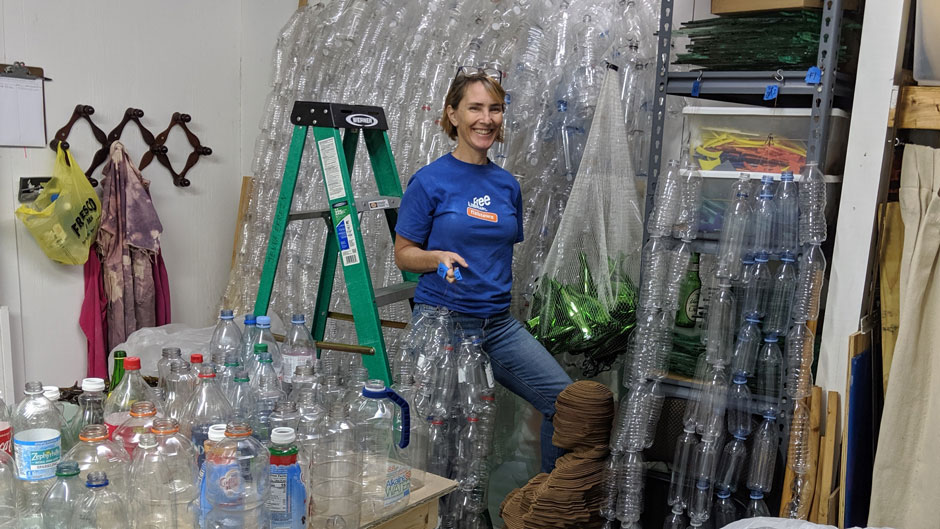Hey, you! Yes, you, the one tossing your plastic water bottle in the trash. How about breaking that bad habit by helping visual artist Jenna Efrein collect the roughly 7,000 clear, plastic bottles she needs for two upcoming public art installations?
That may sound like a lot of plastic water and other beverage bottles, but it’s a mere drop in the vast ocean, which is where too many of the 50 billion plastic water bottles Americans use annually wind up, killing an estimated 1 million marine animals that ingest bits of the synthetic particles every year.
By stringing the bottles on fishing line and hanging them in an undulating “waterway” that people can navigate, Efrein, a senior lecturer in glass in the University of Miami’s Art and Art History Department, hopes to impart a sense of how sea creatures, from the largest killer whales to the teeniest phytoplankton, feel while swimming in oceans of pollution.
“We are all responsible for this. We are all culpable,” said Efrein, who draws attention to societal and environmental issues by fusing sculpture, installation, and social practice art.
“Most of us don’t even use refillable water bottles, even at UM, which makes it so easy. Refillable water fountains are everywhere yet so are throw-away bottles. One of my own students won’t use a refillable bottle because he says he’d leave it somewhere. So he buys plastic.”
Rather than tossing or recycling those bottles, Efrein asks that you drop them off in the Glass Classroom or Hot Shop in the Studio Arts Building so she and fellow artist Christin Paige Minnotte can create at least two more iterations of “Waterway,” their interactive sculpture that made a huge splash when it debuted in September at Collab 6, a pop-up show for artists and by artists.
“Rinsed out would be amazing, de-labeled would be a godsend, but we’ll take them any way,” Efrein said.
Bathed in shimmering light, the original wall of undulating bottles, which measured 20 feet long, 6 feet tall, and 3 feet wide, managed to be both visually and aurally captivating. “The whole sculpture was really a huge irony,” Efrein said. “Under the right light, it shimmered like the ocean, and when you walked through it, it sounded like boats gently knocking on a pier.”
But Efrein wasn’t trying to impart beauty or serenity. She was trying to send the message that one of her friends received while moving through the maze. “He told me that halfway through, he started feeling really guilty about the plastic bottle he was carrying. That was a beautiful moment for me.”
Waterway at Collabo 6 Efrein + Minnotte from christin paige minnotte on Vimeo.
Equally gratifying was the reaction from curators who attended the September show. Three of them asked Efrein and Minnotte to expand “Waterway” for other venues, two which have been confirmed. The first iteration, which will be in the shape of a dome—“like half of an overturned grapefruit”—and feature a troupe of dancers, will pop up at Miami’s Jose Marti Park on Dec. 14, when Keeping Current: A Sea Level Rise Challenge for Greater Miami features performances and interactive art installations that encourage new ways of thinking about climate action.
The second iteration, which will be the largest yet, is slated to open in January at Crandon Park’s Marjory Stoneman Douglas Biscayne Nature Center. Measuring 54 feet across, this “Waterway” will be suspended under a walkway for a month, reminding beach-goers not to take plastic bottles to the beach, or if they must, not to leave the bottles behind.
Though collecting 7,000 bottles for both projects is a huge endeavor, Efrein turned down help from Teddy Lhoutellier, who heads the University’s Office of Sustainability. An admirer of both Efrein’s work and her message, Lhoutellier offered to give her access to UM's large recycling containers so she could retrieve the cache of plastic bottles there.
But that, she said, would defeat “Waterway’s” purpose, which is, in essence, to send people on a guilt trip.
“I want bottles from individual users who go through the purposeful act of collecting them,” Efrein said. “Because that’s how this project will affect change, by making people aware of their own culpability.”
Drop off only clear or very slightly blue- or green-tinted bottles in room 100 of the Studio Arts Building, 1535 Levante Ave., on the Coral Gables campus. Room 100 is the first room on the left side of the Studio Arts Courtyard.
